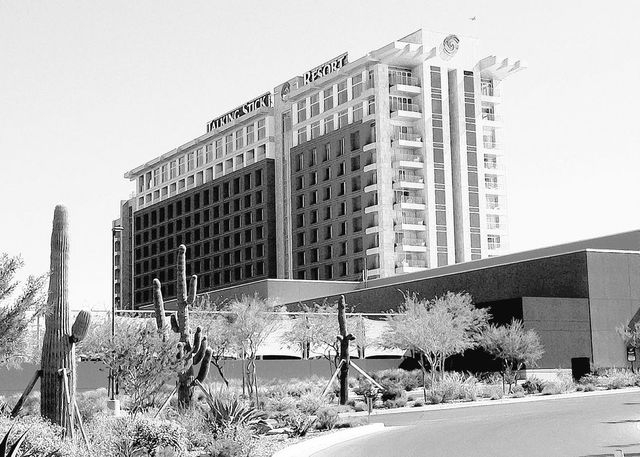Tribe’s Talking Stick Resort wields powerful economic clout

SCOTTSDALE, Ariz.
The Salt River-Pima Indian Community has a real estate footprint in this city, 20 minutes east of downtown Phoenix, that makes the 67-acre CityCenter look like a strip mall.
The tribe has built a “cultural and entertainment destination.”
There is the 36-hole Talking Stick Golf Club, which was designed by noted golf course architects Bill Coore and Ben Crenshaw. On the opposite side of the Arizona 101 Loop is The Pavilions at Talking Stick, a 1.1 million square foot retail center. Near the shopping complex is the Salt River Fields at Talking Stick, an 11,000-seat stadium with 12 practice fields and clubhouse facilities that serve as the spring training home for the Arizona Diamondbacks and Colorado Rockies.
At the center of it all is the Talking Stick Resort, a 496-room hotel-casino.
You get the picture.
For two years straight, Arizona has ranked sixth out of the 28 states in terms of gaming revenue produced by Indian casinos. The newly released Casino City’s Indian Gaming Industry Report shows Arizona’s 22 tribal-owned casinos brought in more than $1.8 billion in 2012, a 3 percent increase over 2011.
The Talking Stick has 752 slot machines along with 51 blackjack tables and a 55-table poker room.
Less than 8 miles away is the Salt River-Pima tribe’s gaming-only Casino Arizona, which operates 911 slot machines, an eight-table poker room and 36 blackjack tables. The draw, however, is a 1,000-seat bingo hall.
The Salt River-Pima tribe is doing its part to help Arizona hold its place among the Indian casino states. But it’s also using the proceeds from its gaming engine to fuel the tribe’s economic presence.
Rick Medina, assistant director of the Arizona Department of Gaming, the regulatory body that oversees the Indian casinos, said the state never envisioned “becoming another Las Vegas.”
The idea, when Indian casinos were approved in 2002, was to give tribes the ability to create an economic benefit to their members, but also provide tax revenue to state and local jurisdictions.
According to Arizona gaming regulations, tribes contribute 1 percent to 8 percent of their net revenue to the state, based on a sliding scale that takes into account numerous factors, Medina said. Of the taxes, 88 percent go to a cumulative fund that benefits that state’s educational system but is divided among other areas, such as emergency services, the state wildlife conservation fund and state tourism.
The other 12 percent is returned to cities and counties where the casinos are located.
Since 2004, Arizona Indian tribes have contributed almost $850 million to the cumulative fund and another $104.6 million to cities, towns and counties.
The trick, Medina said, is to make sure gaming doesn’t expand too quickly.
“It’s a balancing act, for sure,” Medina said. “As the money comes in, there is always pressure to expand and we have to deal with that. We want the gaming to be limited and we review the casinos in five-year increments.”
Tribes are awarded gaming opportunities — slot machines and table games — based on the population of a tribe. Also, tribes that don’t operate casinos can lease gaming rights for up to 500 slot machines to tribes with casinos.
“The compacts are limited, but we want the tribes to do what they can in terms of economic development,” Medina said.
The Navajo Nation opened its first Arizona casino east of Flagstaff in May 2013.
The 15 Arizona tribes that having gaming compacts with the state are now authorized for a total of 18,158 slot machines. According to the department, the tribes are operating 15,442 games.
Just one tribe, the Gila River Indian Community, operates its full allotment of 2,686 slot machines in three casinos around Phoenix.
The Tohono O’odlam Nation has 2,233 slot machines in three casinos near Tucson.
The tribe gained federal approval four years ago to place 54 acres in Glendale, a Phoenix suburb, into trust as historical reservation land. The tribe is negotiating with the city to build a casino near the sports and entertainment district that includes the stadium home of the NFL’s Arizona Cardinals and an arena that houses the NHL’s Phoenix Coyotes.
Tribal chairman Ned Norris Jr. said the casino is projected to have a $300 million annual economic impact for the city.
California economist Alan Meister, who authored the Indian Gaming Report, said the demand for gaming in Arizona stands out.
However, even with the majority of the casinos surrounding the state’s two major population centers in Phoenix and Tucson, Arizona doesn’t cut into Las Vegas’ revenue totals, Meister said.
“The casinos aren’t drawing much business away from Las Vegas,” Meister said. “It’s more of the convenience gaming factor. People come from all over the world to Las Vegas. The Arizona casinos don’t compete with Las Vegas.”
One Nevada company, Caesars Entertainment Corp., operates the Harrah’s Ak Chin casino, 40 miles from downtown Phoenix for the Ak Chin Indian Community.
Meister doesn’t believe Arizona will challenge California, the nation’s leading Indian gaming market that produced $6.91 billion in gaming revenue in 2012, one-quarter of the nation’s overall total of $28.1 billion.
Several of the Arizona casinos are starting to resemble Las Vegas in some ways.
The Talking Stick dominates the landscape outside Scottsdale.
Inside, the resort resembles the Hard Rock, with a circular casino surrounded by amenities but without the rock ‘n’ roll memorabilia.
The Salt River-Pima tribe does have a large cultural display near the hotel tower entrance, but the tribe also displays historical photos and other tribal artifacts throughout the casino and convention area.
Howard Stutz’s Inside Gaming column appears Wednesdays and Sundays. He can be reached at hstutz@reviewjournal.com or 702-477-3871. Follow @howardstutz on Twitter.












